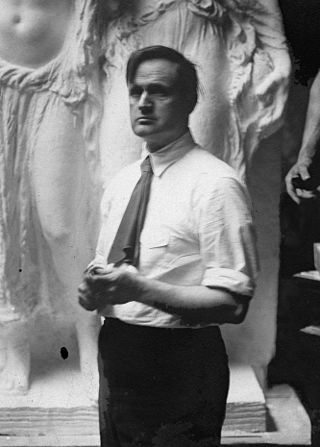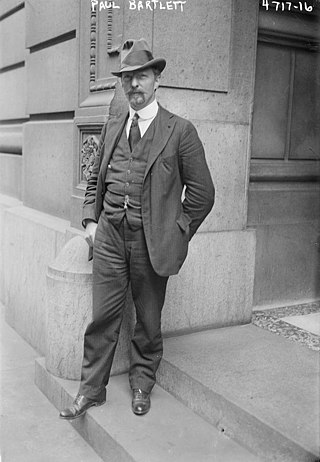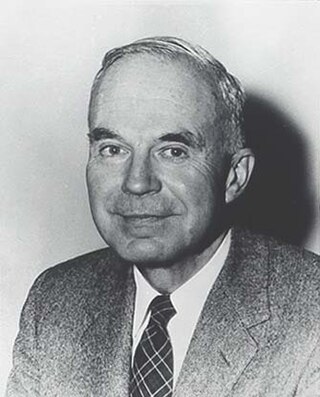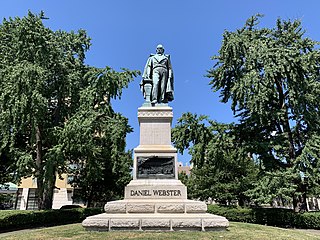
Daniel Chester French was an American sculptor of the late nineteenth and early twentieth centuries. He is best known for his 1874 sculpture The Minute Man in Concord, Massachusetts, and his 1920 monumental statue of Abraham Lincoln in the Lincoln Memorial in Washington, D.C.

Jo Davidson was an American sculptor. Although he specialized in realistic, intense portrait busts, Davidson did not require his subjects to formally pose for him; rather, he observed and spoke with them. He worked primarily with clay, while the final products were typically cast in terra-cotta or bronze, or carved from marble.

Adolph Alexander Weinman was a German-born American sculptor and architectural sculptor.

Karl Theodore Francis Bitter was an Austrian-born American sculptor best known for his architectural sculpture, memorials and residential work.

Alexander Stirling Calder was an American sculptor and teacher. He was the son of sculptor Alexander Milne Calder and the father of sculptor Alexander (Sandy) Calder. His best-known works are George Washington as President on the Washington Square Arch in New York City, the Swann Memorial Fountain in Philadelphia, and the Leif Eriksson Memorial in Reykjavík, Iceland.

James Earle Fraser was an American sculptor during the first half of the 20th century. His work is integral to many of Washington, D.C.'s most iconic structures.

Evelyn Beatrice Longman was an American sculptor whose allegorical figure works were commissioned as monuments and memorials, adornment for public buildings, and attractions at art expositions in the early 20th-century. She became the first woman sculptor to be elected a full member of the National Academy of Design in 1919.

John Quincy Adams Ward was an American sculptor, whose most familiar work is his larger than life-size standing statue of George Washington on the steps of Federal Hall National Memorial in New York City.

Charles Henry Niehaus was an American sculptor.

Paul Wayland Bartlett was an American sculptor working in the Beaux-Arts tradition of heroic realism.

Edward Francis McCartan was an American sculptor, best known for his decorative bronzes done in an elegant style popular in the 1920s.
The Piccirilli brothers were an Italian family of renowned marble carvers and sculptors who carved many of the most significant marble sculptures in the United States, including Daniel Chester French’s colossal Abraham Lincoln (1920) in the Lincoln Memorial, Washington, D.C.

Robert Ingersoll Aitken was an American sculptor. Perhaps his most famous work is the West Pediment of the United States Supreme Court Building.

Walker Kirtland Hancock was an American sculptor and teacher. He created notable monumental sculptures, including the Pennsylvania Railroad World War II Memorial (1950–52) at 30th Street Station in Philadelphia, and the World War I Soldiers' Memorial (1936–38) in St. Louis, Missouri. He made major additions to the National Cathedral in Washington, D.C., including Christ in Majesty (1972), the bas relief over the High Altar. Works by him are presently housed at the U.S. Military Academy at West Point, the Library of Congress, the U.S. Supreme Court, and the United States Capitol.

Carol Brooks MacNeil was an American sculptor, born in Chicago where she studied at the Art Institute of Chicago under Lorado Taft. MacNeil modeled many charming and unique designs for vases, teapots, inkstands, and other decorative and useful objects, as well as children's busts, including those of her two sons, and statuettes.

The Daniel Webster Memorial is a monument in Washington, D.C., honoring U.S. statesman and lawyer Daniel Webster. It is located near Webster's former house, beside Scott Circle, at the intersection of Massachusetts Avenue, N Street, and Rhode Island Avenue NW. The person who commissioned the memorial was Stilson Hutchins, founder of The Washington Post, who greatly admired Webster. Congress approved the memorial in 1898 and the dedication ceremony took place in January 1900. Amongst the attendees at the ceremony were President William McKinley and his cabinet, members of Congress, and Supreme Court justices.

John Clements Gregory was an American sculptor.

The Thomas Burke Monument, also known as Judge Thomas Burke, is a 1929 outdoor sculpture commemorating Thomas Burke by Hermon Atkins MacNeil, located in Volunteer Park, in Seattle's Capitol Hill neighborhood, in the U.S. state of Washington. The monument, which is made of granite, marble, and bronze, was dedicated in 1930. It is part of the Seattle Office of Arts & Culture.

The William McKinley Monument, or McKinley Memorial, is a statue and memorial honoring the assassinated United States President William McKinley which stands on Capitol Square to the west of main entrance of the Ohio Statehouse in Downtown Columbus, Ohio.

Ezra Cornell is a monumental statue in Ithaca, New York, United States. Located on the Arts Quad of the Cornell Central Campus, the monument honors Ezra Cornell, the co-founder and namesake of Cornell University. The statue, designed by Hermon Atkins MacNeil, was dedicated in 1919.
































